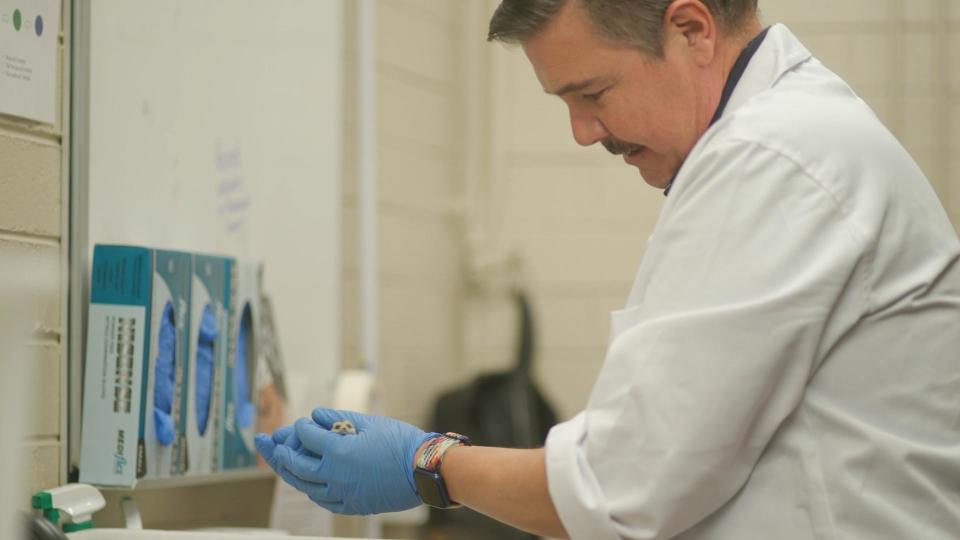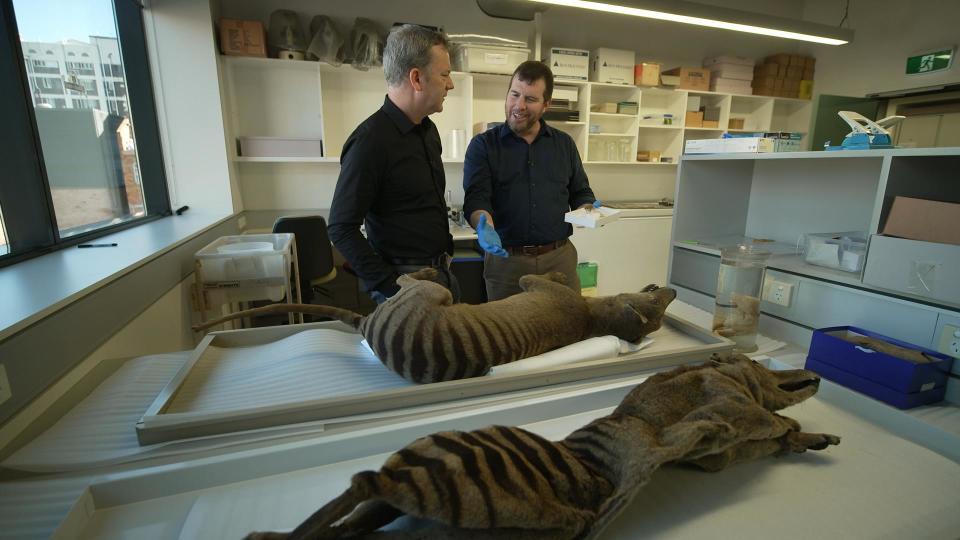Aussies determined to find or bring back the extinct Tasmanian tiger
It's been nearly 40 years since the extinction of Australia's thylacine, known as the Tasmanian tiger, but reported sightings come by the thousands as people across Tasmania tramp through the dense outback in search of the lost species.
For the seekers, the investment isn't just one of hope and time. Adrian "Richo" Richardson, a retired military man turned self-declared tiger seeker, has spent more than 30 years looking for a Tasmanian tiger. Each year, he spends more than he cares to admit on trail camera batteries alone.
"I wouldn't like to speculate," he said. "And please don't tell my wife."
How an apex predator died off
Tasmanian tigers, carnivores weighing about 55 pounds, roamed Tasmania for thousands of years. They were more similar to wolves than tigers. The Tasmanian tiger was, or is (as some believers might say) a marsupial, like kangaroos, koalas and Tasmanian devils.
In the late 1800s when farmers' sheep ended up as prey, the local government paid out bounties to hunters presenting carcasses of Tasmanian tigers. The population had dwindled to one by the mid-1930s: a Tasmanian tiger captive at Beaumaris Zoo in Hobart, Tasmania's capital.
It died there in 1936. The Tasmanian tiger was put on the extinct list in 1986, after 50 years elapsed without a confirmed sighting.
Australia has similarly permitted the culling of Kangaroos, approving the deaths of thousands of kangaroos over the years, saying the animal was growing in population and eating through grassy habitats of endangered species. Large population numbers also pose a risk to kangaroos themselves, with officials warning in the past that there isn't enough food available for the kangaroos to survive.
Aussies search far and wide for signs of Tasmanian tigers
While kangaroos are emblematic of Australia, the search for the Tasmanian tiger has become an obsession. Though the Tasmanian devil still lives, it's the tiger that's become a sort of local mascot. Its image adorns Tasmania's coat of arms and the island's license plate.

Searchers scour for prints, fur and scats—and post trail-cameras in remote areas all over the Tasmanian outback.
On Jan. 28, 2017, Richardson heard a howl.
"I was gobsmacked," he said. "The hairs on my arm and my neck stood on end."
Then he heard another howl.
"The whole environment went quiet for about a minute," he said. "It was an unbelievable feeling. I just can't explain it."
He didn't see any sign of a Tasmanian tiger, but he's sure of what he heard. Richardson dismissed the idea that the sound could be anything but a Tasmanian tiger. There are no other species like it on the island, he said.
"I'm going to remember that call until the time I die," he said. "And then I had to try and prove to others what I've heard."
When he returned to his Hobart home, Richardson sat down at his desk and wrote up a detailed account with 22 footnotes.
"[It's] what my passion is. It's the thylacine," he said. "I know it's there."
Reviewing the reported Tasmanian tiger sightings
When Nick Mooney was a full-time Hobart biologist, it fell to him to investigate the various Tasmanian tiger accounts. Now in retirement, he's the island's unofficial arbiter. He can't help but notice: no one ever quite captures a clear image. Still, some of the reports have given him pause.
"Sometimes people are dead accurate with the times, the places, the distances," Mooney said. "And if they're close distances, five meters, 10 meters in good light – well, they can't really be wrong."
Good naturalists don't exaggerate, he said. They take their skills very seriously.
"And it's very hard to say to those people – 'I don't think you saw a thylacine,'" Mooney said.
Some searchers join tracking collectives. Richardson was part of the Booth Richardson Tiger Team, which made worldwide news in 2017 after calling a press conference to announce a sighting.
They provided an image as evidence, but Mooney assessed it as a "chance" and not an official confirmation.
Efforts to bring the Tasmanian tiger back with science
While searchers continue looking for signs of Tasmanian tigers in the wild, scientists are trying to revive the species in their labs. Andrew Pask, a developmental biologist who works out of the TIGRR lab, is leading one such project.
"We can't magically bring the Tasmanian tiger back," Pask said. "We have to start with a living cell, and then engineer our thylacine back into existence. So, the way you do that is you find the closest living relative to your animal that has gone extinct, and for us that is a small marsupial species called the fat-tailed dunnart."
In other words, the closest living relative of an apex predator known as the Tasmanian tiger is a mouse-like marsupial.

"But that little dunnart is a ferocious carnivore, even though it's very, very small," Pask said. "And it's a very good surrogate for us to be able to do all of this editing in."
Pask has raised $15 million for a de-extinction project in partnership with American company Colossal Biosciences, which counts Leonardo DiCaprio, Paris Hilton and even the C.I.A. among its backers. They're examining the dunnart's DNA and comparing it with the DNA of the Tasmanian tiger.
"And we look at everywhere that those two genomes, or those two piles of DNA, if you like, are different," Pask said.
After finding all the differences, Pask told Jon Wertheim, it's a matter of going in and editing the DNA to turn a fat-tailed dunnart cell into a thylacine cell.
Efforts aiding the revival of the Tasmanian tiger are not confined to Australia. Last year, scientists recovered and sequenced RNA from a 130-year-old Tasmanian tiger specimen preserved at room temperature in Sweden's Museum of Natural History.
Is bringing back the Tasmanian tiger possible?
Australian Museum Research Institute Chief Scientist and Director Kris Helgen understands the push to de-extinct the Tasmanian tiger. He says he'd be the first person to line up and see a Tasmanian tiger if the species were actually brought back to life. Helgen just doesn't think it's possible.
"The idea that you could actually tweak the DNA of this mouse-sized animal into making this apex predator of Australia, it stretches imagination in many different ways," he said.

He puts the chance of success at zero, saying there are just too many differences between the fat-tailed dunnart and the Tasmanian tiger.
"I think that this is an impossible project," he said.
Helgen has thought a lot about the source of the Tasmanian tiger passion and wonders how much of it is driven by remorse.
"It's a special symbol about Australia and about what we've lost," he said. "We've had a lot of extinctions here."
Richardson isn't waiting on scientists — faith unshaken, he plans to continue his search for the Tasmanian tiger.
"I just know it's there. I do," he said. "In my own heart, I know it's there."
Jerry Seinfeld on "Unfrosted," the made-up origin tale of Pop-Tarts

